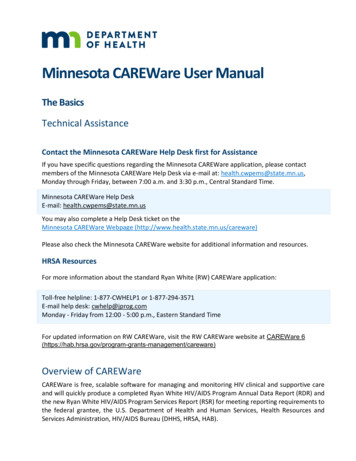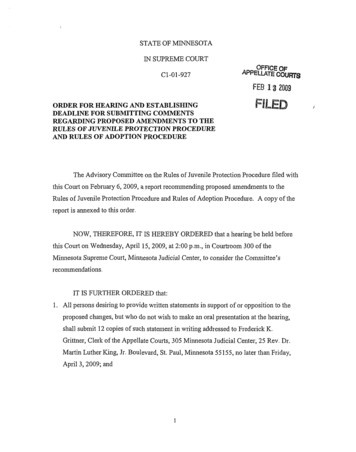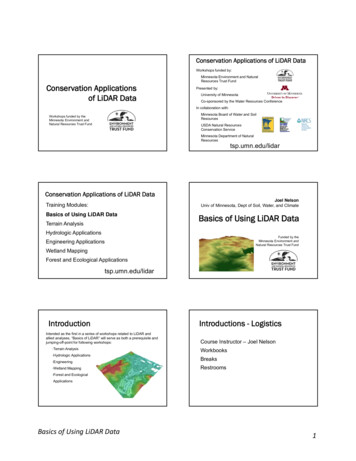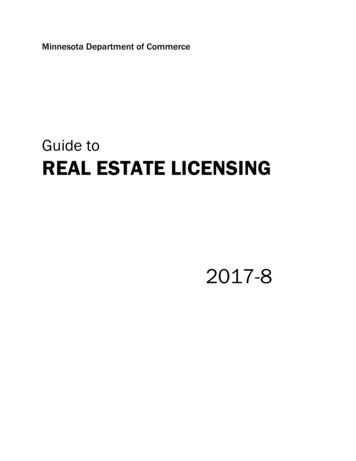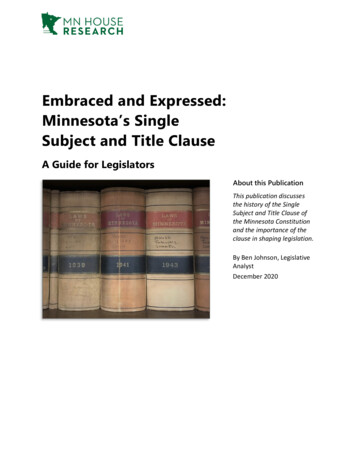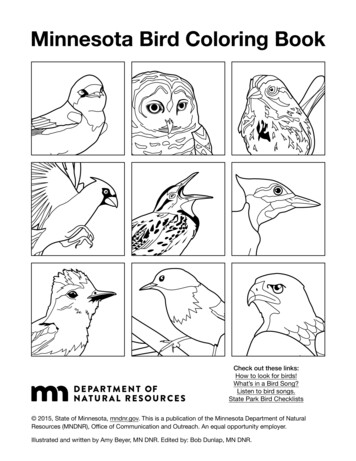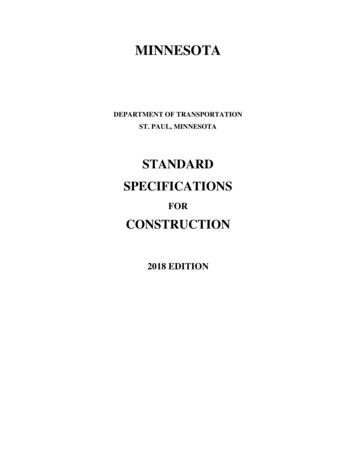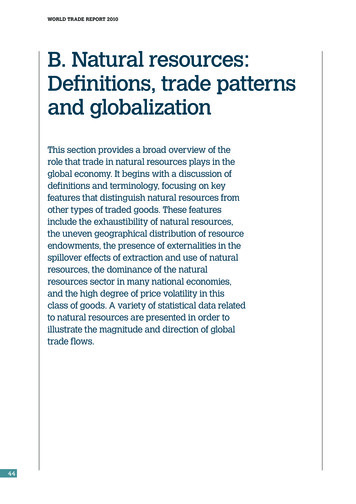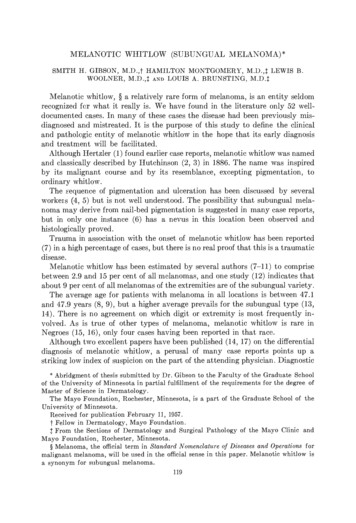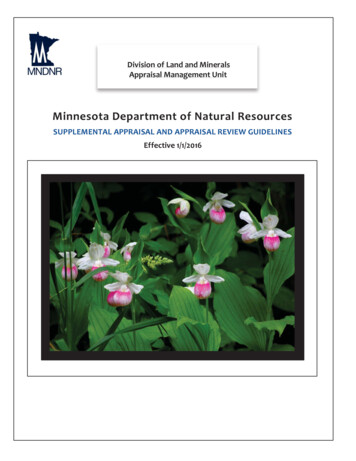
Transcription
Division of Land and MineralsAppraisal Management UnitMinnesota Department of Natural ResourcesSUPPLEMENTAL APPRAISAL AND APPRAISAL REVIEW GUIDELINESEffective 1/1/2016
Supplemental Appraisal and Appraisal Review GuidelinesSupplemental Appraisal and Appraisal Review GuidelinesI. Appraiser/Reviewer Qualifications. 3A. Department of Natural Resources (DNR) Appraiser/Reviewer Qualifications. 3II. General Appraisal Standards. 3A. DNR Supplemental Appraisal and Appraisal Review Guidelines. 3B. Uniform Standards of Professional Appraisal Practice (USPAP) . 3C. Uniform Appraisal Standards for Federal Land Acquisitions (UASFLA) . 3D. Federal Highway. 3E. Minnesota Standards of Conduct and Contract Compliance . 3III. Statutory and DNR-Specific Standards.4A. DNR Appraisals and DNR Appraisal Reviews are Confidential Data . 4B. Conflict of Interest . 4C. Landowner Appraisal - Acquisitions . 4D. Need to Remedy Deficiencies . 4E. Extraordinary Assumptions and Hypothetical Conditions . 4F. Waivers . 4G. Potentially Contaminated Property Appraisal or Environmental Nuisances. 5H. Shelf Life . 5I.Property Information Packet . 5J.Other Communications . 5K. Performance .6L. Invasive Species.6IV. Types of Appraisal Projects. 6A. DNR Ordered Appraisal.6B. Landowner Appraisal (Acquisition Projects Only) .6C. Land Trust Appraisal (Acquisition Projects Only) . 7D. Grant Appraisal (Acquisition Projects Only). 7V. Types of Appraisal Reports . 7A. Restricted Report .8B. Appraisal Report.8C. Minimal Value Report for Acquisitions and Exchanges (as allowed under statute 84.0272 Subd. 3) .8D. Minimal Value Report for Land Sales (as allowed under statutes 92.115 and 94.10) .8VI. Required Number of Appraisals . 9VII. Appraisal and Review Assignment Process . 9A. Assignment Process .9B. Accountability of Assigned Appraiser .9C. Changes in Assignment . 10D. Appraisal Update Policy . 10VIII. Appraisal Standards and Appraisal Reporting Requirements . 10A. Introduction . 11B. Scope of Work . 111 P a g e
Supplemental Appraisal and Appraisal Review W.Factual Data .12Data Analysis and Conclusions.12Correlation, Reconciliation and Final Value Estimates .12Exhibits and Addenda . 13Partial-Taking Valuations and Before and After. 13Miscellaneous Reporting Requirements . 14Data to be furnished by the State, Grant Recipient or Partner (in writing) . 14Conservation Program Encumbrances. 14Public Interest Value . 14Application of Cost Approach. 15Sales Comparison Approach – Qualitative and Quantitative Adjustments . 15Sales Comparison Approach-Use of 1031 Exchange Transactions as Comparable Data . 15Sales Comparison Approach-Use of Government Sales and Quasi-Government Sales as Comparable Data. 16Valuation of Properties encumbered with Life Estates or Term for Years Estates. 16Appraising Undivided Partial Interests. 16Valuation of Access Issues Specific to DNR Acquisitions . 16Appraising Properties with Potential Aggregate (Sand or Gravel) Resources: . 17Mineral Valuation . 17Appraising Conservation Easements. 18Conservation Easements and Mineral Rights . 18Timber Valuation Guidelines . 18IX. Exchange Appraisal Requirements . 19A. Specific Requirements . 19B. Mineral Reservation in Land Exchanges . 20X. Appraisal Review Standards and Reporting Requirements . 20A. Technical Reviewer’s Function . 20B. Scope of Work . 20C. Technical Level of Review.21D. Technical Reviewer Responsibilities:.21E. Technical Reviewer Reporting Requirements . 22F. Review Appraiser Communication . 22G. Concurring Technical Review. 23H. Review Appraiser’s File . 23Technical Reviewer Becoming the Appraiser of Record . 23I.J.Multiple Appraisal Reports and Divergency. 24K. Technical Reviews on Land Trust or Grant Projects – Additional Requirements . 24L. Administrative Appraisal Review Guidelines. 25M. Reviewer Conflict of Interest Situations . 25XI. REPORT SUBMISSION. 25A. Electronically . 25B. By Mail. 26XII. DEFINITIONS . 262 P a g e
Supplemental Appraisal and Appraisal Review GuidelinesI. APPRAISER/REVIEWER QUALIFICATIONSA. Department of Natural Resources (DNR) Appraiser/Reviewer Qualifications1.Appraiser Qualificationsa. Appraiser must be licensed with the State of Minnesota as a Certified General Appraiser in goodstanding.b. Current license requirements can be found by contacting the Minnesota Department of Commerce.c. Appraiser must meet the Competency Provision of USPAP for each assignment.2.Reviewer Qualificationsa. Reviewer must be licensed with the State of Minnesota as a Certified General Appraiser in goodstanding.b. Reviewer must meet the Competency Provision of USPAP for each assignment.c. Additional Federal Program Qualifications:i. Reviewer must have documented authority from the appropriate Federal agencyII. GENERAL APPRAISAL STANDARDSA. DNR Supplemental Appraisal and Appraisal Review GuidelinesThe Department of Natural Resources (DNR) publishes its own supplemental guidelines so that it can supplementthe purpose, intent and content of the requirements of USPAP and obtain appraisals that comply with a variety ofreporting standardsB. Uniform Standards of Professional Appraisal Practice (USPAP)The Department requires that such reports adhere to state statutes and the most current version of the UniformStandards of Professional Appraisal Practice (USPAP) as published by the Appraisal Foundation and state statutes.Appraisers should be accustomed to using the USPAP guidelines and be familiar with the advisory opinions issuedby the Appraisal Foundation on specific topics.C. Uniform Appraisal Standards for Federal Land Acquisitions (UASFLA)In some cases, the DNR appraisal assignment also requires adherence to Uniform Appraisal Standards for FederalLand Acquisitions (UASFLA). The UASFLA requirements are detailed in printed guidelines by the same name, alsoreferred to as the “yellow book.” Appraisers who accept assignments which must be completed to federalstandards should be competent to appraise and write reports according to with the “yellow book” standards andable to tailor their appraisals to those standards.D. Federal HighwayAppraisers who conduct DNR appraisals for grant-in-aid trails must also be approved to do appraisals for FederalHighway Administration guidelines.E. Minnesota Standards of Conduct and Contract ComplianceAppraiser must abide by the Minnesota Standards of Conduct Statute 82B, and the DNR contract underwhich the work order is issued.3 P a g e
Supplemental Appraisal and Appraisal Review GuidelinesIII. STATUTORY AND DNR-SPECIFIC STANDARDSA. DNR Appraisals and DNR Appraisal Reviews are Confidential DataCertain appraisal information is considered confidential (protected non-public data) by the DNR. Appraisal datathat is protected non-public shall not be released to any individual outside of the Lands and Minerals AppraisalManagement Unit (AMU) without the approval of the Lands and Minerals Director, Assistant Director or AppraisalUnit Supervisor.B. Conflict of InterestStaff and fee appraisers must disqualify themselves from appraising properties where there is a personal orbusiness relationship in the property to be appraised or reviewed.C. Landowner Appraisal - AcquisitionsThe Landowner has a right to retain a qualified independent appraiser to conduct an appraisal at any time foracquisitions. To have the landowner appraisal be considered with the state’s appraisal, the report must be receivedby the Division of Lands and Minerals prior to the review and certification of the state’s appraisal of the property. Ifa landowner appraisal is received, the DNR appraisal and the landowner appraisal will be reviewed together.D. Need to Remedy DeficienciesTechnical and Administrative reviewers will review appraisals. The assigned appraiser has the responsibility to workwith the reviewer to remedy deficiencies in a timely manner. This responsibility is part of the Appraisal Assignmentand the contractor should take into consideration when bidding on a project.E. Extraordinary Assumptions and Hypothetical ConditionsAny “extraordinary assumptions” or “hypothetical conditions” developed as a part of the appraisal project must bediscussed with the Appraisal Unit Supervisor, and preapproved, before they are used in the final report. There areonly two exceptions to this rule:1.2.If the transaction involves a Land Trust appraisal, the property must be valued as though the state ispurchasing it directly from the landowner. The appraiser must include this assumption as a “hypotheticalcondition” in the appraisal.If the transaction involves a Conservation Easement valuation, the appraiser must assume a “hypotheticalcondition” in the after-valuation perspective – that the property is encumbered with the easement.When using a “hypothetical condition” or “extraordinary assumption,” the report must state that their use mighthave affected the assignment results.F. WaiversWhen the landowner is a non-profit organization or a unit of government, the DNR and the landowner may enterinto an agreement to waive any of the rights identified in the Landowner’s Bill of Rights law. With respect tocontract appraisal assignments, such a waiver may include the requirement for the appraiser to physically inspectthe property, or the requirement to give the landowner an opportunity to accompany the appraiser during theproperty inspection, or the length of time during which the DNR is to strive to acquire the property. The appraiserwill be advised of any waiver of rights by the landowner that may affect the scope of work or analysis.4 P a g e
Supplemental Appraisal and Appraisal Review GuidelinesG. Potentially Contaminated Property Appraisal or Environmental NuisancesThe appraiser’s primary responsibility is to photograph any areas of suspected contamination or environmentalnuisance (if possible) and notify the Appraisal Unit Supervisor, Grant Project Manager or Partner Project Managerof anything discovered either in on-site inspections or in background research.The Appraiser will be directed to appraise the property in one of two ways:1.2.Appraise the property as though the concern were removed (hypothetical condition).a. This will result in one of the following actions:i. Landowner will clean up prior to closing.ii. DNR administration (this is not an option for Grant or Partner Projects) will administrativelyreduce the value of property due to the environmental condition based on a cost to cure estimatefrom either:(a) DNR Management Resources(b) A qualified specialist in environmental remediationAppraise the property as is, relying on the findings and opinions of qualified specialists in environmentalremediation and compliance cost estimations.a. Appraiser must consider if the condition will result in stigma and affect the market value.b. Copies of estimates provided by others should be included in the addendum of the report .H. Shelf LifeThe longevity of an appraisal report is contin ent primarily on the volatility of the real estate markets in thevicinity of the subject property. It has generally been DNR policy to seek a new or updated appraisal whenever areport is more than twelve months old. The DNR or Grant Recipient may choose to require an update sooner.1.2.For any appraisal report that is more than one year old, the Appraisal Unit Supervisor may contact the originalappraiser and consult with him/her on whether an update is called for by the prevailing market conditions.If an update is deemed necessary, the appraiser should be assigned to provide the appropriate report anddocumentation (in accordance with contract).I. Property Information PacketA property information packet may be provided to the appraiser. Information is deemed reliable, although it is theappraisers or reviewers responsibility to bid the project understanding that the information is not guaranteed andrequires independent verification.J. Other Communications1.2.3.DNR contract appraisers should not communicate with any DNR staff person except for AppraisalManagement Unit staff unless authorized. If contacted by other DNR staff for any reason, the appraiser shouldpolitely ask the staff person to call the Appraisal Management Unit. The appraiser should then notify the AMUof the contact so that we may do the appropriate follow up.The appraiser is required to contact the landowner to offer him or her the opportunity to accompany theappraiser on his or her site inspection. If the landowner indicates information that differs from the appraiser’sinstructions and other written documentation, the appraiser shall contact the Appraisal Management Unitimmediately.The appraiser is not authorized or required to work on the project once the assignment is complete. Ifcontacted to discuss the assignment, refer the inquiry to the Appraisal Management Unit.5 P a g e
Supplemental Appraisal and Appraisal Review Guidelines4.Appraised value data may be non-public data. Appraised value data shall not be released by the appraiser orreviewer to any individual outside of the Appraisal Management Unit without the approval of the Lands andMinerals Director or Assistant Director.K. Performance1.2.3.Failure to provide documentation as prescribed in accordance with appropriate standards will require theappraiser to further substantiate the report at no additional cost to the State.All assignments are time-sensitive projects. The report must be received by the due date, or the assignment issubject to cancellation for non-performance. Any changes in the timeline must be approved by the AppraisalUnit Supervisor.Unsatisfactory contractor performance will be documented in a Contractor Performance Report, whichbecomes part of the contractor’s file. Contract performance issues can result in termination of the contract.L. Invasive SpeciesIf a property has been identified as a property with invasive species, the appraiser shall observe the followingprecautions:1. Brush off dirt and debris and dump out pant cuffs before entering or exiting the property.2. Before leaving for the field and/or entering a property, walk around and visually inspect for and remove cakedmud, dirt clods, plants and plant parts, bark and debris. Power washing is recommended, but not required.3. Avoid moving through existing patches of invasive species going to and from the property. Before leaving theproperty, walk around and visually inspect for and remove caked mud, dirt clods, plants and plant parts, barkand debris.4. Brush, sweep, wash or remove by hand plants, seeds, mud, soil and animals from vehicles and equipmentincluding: wheel wells, tracks, hubs, blades, grills, etc.5. Before leaving an aquatic property (or water source), drain water from any equipment, tanks or waterretaining components.IV. TYPES OF APPRAISAL PROJECTSA. DNR Ordered Appraisal1.2.3.The DNR orders appraisals to meet statutory and program requirements.Such appraisal reports must comply with Uniform Standards of Professional Appraisal Practice (USPAP) andthe DNR Supplemental Appraisal and Appraisal Review Guidelines.The Appraisal Unit Supervisor is the contact for appraisal-related questions.B. Landowner Appraisal (Acquisition Projects Only)1.2.3.4.The landowner has a right to retain a qualified independent appraiser to conduct an appraisal. The report mustbe received by the Appraisal Management Unit prior to the review and certification of the state’s appraisal ofthe property. If a landowner appraisal is received, the DNR appraisal and the landowner appraisal will bereviewed together.Such appraisal reports must comply with Uniform Standards of Professional Appraisal Practice (USPAP).The landowner should ask their appraiser to name the DNR as an intended user in the report. The landownershould be advised of the appraisal standards required to meet funding objectives.In cases where the landowner is the client, the appraiser’s contact for appraisal-related questions is thelandowner or authorized representative. The DNR Appraisal Unit Supervisor is also available as a resource.6 P a g e
Supplemental Appraisal and Appraisal Review GuidelinesC. Land Trust Appraisal (Acquisition Projects Only)The following are specific requirements for Land Trust Appraisals; they must also comply with USPAP and the DNRSupplemental Appraisal and Appraisal Review Guidelines.1.2.3.4.5.6.7.The DNR may agree in writing to proceed with a Land Trust appraisal transaction for the DNR’s potentialpurchase of a property from a non-profit or governmental organization.This type of project will be identified by a written Letter of Intent between the DNR and the Partner.The Land Trust must have been issued a Land Trust “Letter of Intent” from the DNR prior to the appraisal – thisletter should be included in the addendum of the appraisal report.The appraiser should be made aware that the DNR will be reviewing the report and must agree to work withthe reviewer as needed.The appraiser must analyze and report all agreements of sale, options or listings of the subject property as ofthe effective date of the appraisal, and provide copies in the addendum of the report.Unless otherwise stated, the property must be valued as though the state is purchasing it directly from thelandowner. The appraiser must include this assumption as a “hypothetical condition” in the appraisal.The Land Trust’s written appraisal instructions must be included in the addendum of the appraisal report. Theappraiser will also make note of any verbal instructions and provide.D. Grant Appraisal (Acquisition Projects Only)The following are specific requirements for Grant Appraisals; they must also comply with USPAP and the DNRSupplemental Appraisal and Appraisal Review Guidelines.1.This type of project will be identified by a Grant Agreement between the State of Minnesota and the GrantRecipient.2. Specific Appraisal and Appraisal Review instructions are listed on Attachment E as provided by your grantadministrator. Attachment E is also available on the Appraisal Management Unit page of the DNR website.3. For such appraisals, the contact for appraisal-related questions is the Grant Recipient Project Manager unlessthe guidelines direct the appraiser to the DNR Appraisal Unit Supervisor.4. The appraisal guidelines provide information on uniform requirements for all DNR grant programs that fundland acquisition projects. The appraiser will keep in mind they are designed to ensure fairness, and protect theinterests of landowners, grant recipients and the taxpayers of Minnesota.5. The intended use of grant appraisals shall include negotiation and grant reimbursement.6. The intended user is the grant administrator and the State of Minnesota.7. The appraiser should be made aware that the DNR may be reviewing the report and must agree to work withthe reviewer as needed.8. The appraiser must analyze and report all agreements of sale, options, or listings of the subject property as ofthe effective date of the appraisal and provide copies in the addendum of the report.9. Unless otherwise stated, the property must be valued as though the DNR is purchasing it directly from thelandowner. The appraiser must include this assumption as a “hypothetical condition” in the appraisal.10. The written appraisal instructions must be included in the addendum of the report. The appraiser will alsomake not of any verbal instructions and provide.V. TYPES OF APPRAISAL REPORTSThe appropriate reporting option and level of information necessary in the report are dependent on the intended use andintended users. Generally, the complexity, funding, value and type of the property appraised help the AppraisalManagement Unit determine the desired level of detail required.7 P a g e
Supplemental Appraisal and Appraisal Review GuidelinesA. Restricted ReportThe DNR does not use or accept restricted reports.B. Appraisal ReportThe reporting format is determined by the project complexity and level of detail needed to communicate theappraisal problem. Below are some general guidelines the AMU uses to determine the level of detail required inreporting. For further clarification, please c
c. Appraiser must meet the Competency Provision of USPAP for each assignment. 2. Reviewer Qualifications a. Reviewer must be licensed with the State of Minnesota as a Certified General Appraiser in good standing. b. Reviewer must meet the Competency Provision of USPAP for each ass

